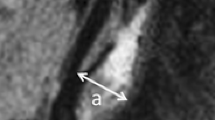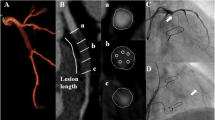Abstract
Background
Carotid artery stenting (CAS) requires follow-up imaging to assess in-stent restenosis (ISR). This study aimed to determine whether non-enhanced magnetic resonance angiography (NE-MRA) is useful for evaluating ISR.
Method
Between 2009 and 2013, we performed 118 consecutive CAS procedures using the Precise stent (n = 78) and the Carotid Wallstent (n = 40). We reviewed 1.5 T NE-MRA and examined visualization of the stent lumen and the degree of ISR if present. Other imaging modalities were used as references.
Results
NE-MRA performed just after CAS was not able to visualize the stent lumen in all patients because of metal artifacts. In the Carotid Wallstent group, follow-up NE-MRA was available in 22 patients. The stent lumen was visible more than three months after CAS in all patients. Among them, >40 % ISR was observed by other modalities in eight lesions. The degree of restenosis measured by NE-MRA (y%) had a linear relationship with that measured by conventional angiography (x%) (y = 0.97x-0.4, r = 0.79, P = 0.021). In one case among 17 without ISR (6 %), NE-MRA showed false ISR. In the Precise stent group, NE-MRA did not visualize the stent lumen in the follow-up period.
Conclusions
NE-MRA can visualize the stent lumen in the Carotid Wallstent more than three months after CAS, but not in the Precise stent at follow-up. This delayed visualization might depend on endothelialization of the stent lumen. The degree of ISR measured by NE-MRA is comparable to that by conventional angiography. NE-MRA can evaluate ISR after CAS with the Carotid Wallstent (100 % sensitivity and 94 % specificity).





Similar content being viewed by others
References
Agarwal R, Brunelli SM, Williams K, Mitchell MD, Feldman HI, Umscheid CA (2009) Gadolinium-based contrast agents and nephrogenic systemic fibrosis: a systematic review and meta-analysis. Nephrol Dial Transplant 24:856–863
Amano Y, Gemma K, Kawamata H, Kumazaki T (1998) Intraluminal signal intensity of iliac artery stents investigated by contrast-enhanced three-dimensional MR angiography. Comput Med Imaging Graph 22:9–12
Arquizan C, Trinquart L, Touboul PJ, Long A, Feasson S, Terriat B, Gobin-Metteil MP, Guidolin B, Cohen S, Mas JL, EVA-3S Investigators (2011) Restenosis is more frequent after carotid stenting than after endarterectomy: the EVA-3S study. Stroke 42:1015–1020
Bonati LH, Ederle J, McCabe DJ, Dobson J, Featherstone RL, Gaines PA, Beard JD, Venables GS, Markus HS, Clifton A, Sandercock P, Brown MM, Investigators CAVATAS (2009) Long-term risk of carotid restenosis in patients randomly assigned to endovascular treatment or endarterectomy in the Carotid and Vertebral Artery Transluminal Angioplasty Study (CAVATAS): long-term follow-up of a randomised trial. Lancet Neurol 8:908–917
Borisch I, Hamer OW, Zorger N, Feuerbach S, Link J (2005) In vivo evaluation of the carotid wallstent on three-dimensional contrast material-enhanced MR angiography: influence of artifacts on the visibility of stent lumina. J Vasc Interv Radiol 16:669–677
Cavagna E, Berletti R, Schiavon F (2001) In vivo evaluation of intravascular stents at three-dimensional MR angiography. Eur Radiol 11:2531–2535
Eckstein HH, Ringleb P, Allenberg JR, Berger J, Fraedrich G, Hacke W, Hennerici M, Stingele R, Fiehler J, Zeumer H, Jansen O (2008) Results of the Stent-Protected Angioplasty versus Carotid Endarterectomy (SPACE) study to treat symptomatic stenoses at 2 years: a multinational, prospective, randomised trial. Lancet Neurol 7:893–902
Hagspiel KD, Leung DA, Nandalur KR, Angle JF, Dulai HS, Spinosa DJ, Matsumoto AH, Christopher JM, Ahmed H, Berr SS (2005) Contrast-enhanced MR angiography at 1.5 T after implantation of platinum stents: in vitro and in vivo comparison with conventional stent designs. AJR Am J Roentgenol 184:288–294
Hamer OW, Borisch I, Paetzel C, Nitz WR, Seitz J, Feuerbach S, Zorger N (2006) In vitro evaluation of stent patency and in-stent stenoses in 10 metallic stents using MR angiography. Br J Radiol 79:636–643
Hähnel S, Nguyen-Trong TH, Rohde S, Hartmann M, Braun C, Sartor K, Heiland S (2006) 3.0 Tesla contrast-enhanced MR angiography of carotid artery stents: in vitro measurements as compared with 1.5 Tesla. J Neuroradiol 33:75–80
Hilfiker PR, Quick HH, Pfammatter T, Schmidt M, Debatin JF (1999) Three-dimensional MR angiography of a nitinol-based abdominal aortic stent graft: assessment of heating and imaging characteristics. Eur Radiol 9:1775–1780
Lal BK, Beach KW, Roubin GS, Lutsep HL, Moore WS, Malas MB, Chiu D, Gonzales NR, Burke JL, Rinaldi M, Elmore JR, Weaver FA, Narins CR, Foster M, Hodgson KJ, Shepard AD, Meschia JF, Bergelin RO, Voeks JH, Howard G, Brott TG (2012) Restenosis after carotid artery stenting and endarterectomy: a secondary analysis of CREST, a randomised controlled trial. The Lancet Neurology 11:755–763
Lettau M, Sauer A, Heiland S, Rohde S, Bendszus M, Hähnel S (2009) Carotid artery stents: in vitro comparison of different stent designs and sizes using CT angiography and contrast-enhanced MR angiography at 1.5 T and 3 T. AJNR Am J Neuroradiol 30:1993–1997
Link J, Steffens JC, Brossmann J, Graessner J, Hackethal S, Heller M (1999) Iliofemoral arterial occlusive disease: contrast-enhanced MR angiography for preinterventional evaluation and follow-up after stent placement. Radiology 212:371–377
Maintz D, Kugel H, Schellhammer F, Landwehr P (2001) In vitro evaluation of intravascular stent artifacts in three-dimensional MR angiography. Invest Radiol 36:218–224
Schürmann K, Lahann J, Niggemann P, Klosterhalfen B, Meyer J, Kulisch A, Klee D, Günther RW, Vorwerk D (2004) Biologic response to polymer-coated stents: in vitro analysis and results in an iliac artery sheep model. Radiology 230:151–162
Strotzer M, Lenhart M, Butz B, Völk M, Manke C, Feuerbach S (2001) Appearance of vascular stents in computed tomographic angiography: in vitro examination of 14 different stent types. Invest Radiol 36:652–658
Vorwerk D, Guenther RW, Gehl HB, Bohndorf K (1990) Color-coded image-directed Doppler sonography compared with digital subtraction angiography in the follow-up of percutaneous vascular endoprostheses. J Clin Ultrasound 18:631–637
Wall A, Kugel H, Bachman R, Matuszewski L, Krämer S, Heindel W, Maintz D (2005) 3.0 T vs. 1.5 T MR angiography: in vitro comparison of intravascular stent artifacts. J Magn Reson Imaging 22:772–779
Wang Y, Truong TN, Yen C, Bilecen D, Watts R, Trost DW, Prince MR (2003) Quantitative evaluation of susceptibility and shielding effects of nitinol, platinum, cobalt-alloy, and stainless steel stents. Magn Reson Med 49:972–976
Wasser K, Schnaudigel S, Wohlfahrt J, Psychogios MN, Schramm P, Knauth M, Gröschel K (2012) Clinical impact and predictors of carotid artery in-stent restenosis. J Neurol 259:1896–1902
Conflicts of interest
None.
Author information
Authors and Affiliations
Corresponding author
Rights and permissions
About this article
Cite this article
Kono, K., Shintani, A. & Terada, T. Non-enhanced magnetic resonance angiography can evaluate restenosis after carotid artery stenting with the Carotid Wallstent. Acta Neurochir 156, 1713–1719 (2014). https://doi.org/10.1007/s00701-014-2142-5
Received:
Accepted:
Published:
Issue Date:
DOI: https://doi.org/10.1007/s00701-014-2142-5




